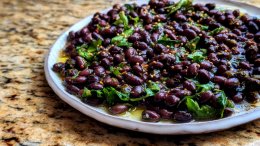Who knew there was so much history behind produce like carrots, artichokes and figs? We did!
Artichokes
These prickly guys were once harshly deemed as “one of the earth’s monstrosities” by Roman naturalist Piney the Elder. Perhaps he didn’t like the hard labour that came along with the stiff, but leafy vegetable (although it’s doubtful that he prepared them himself), or maybe they just weren’t pretty enough for his liking. Despite his disdain, the artichoke has a long and rich history, touching the lives of Greek gods, kings, queens, farmers, mobsters and others. It’s believed they came from the Mediterranean and the Canary Islands, but we can thank French immigrants for bringing them to our great continent in the early 1800s.
Avocados
For many years, avocados carried around the reputation of being a misunderstood town harlot. Rumour has it, people avoided eating the creamy fruit (yes, fruit) because of a long-lasting belief that it induces sexual prowess, with their physical shape so closely resembling… well, testicles. Those wishing to protect themselves from town gossip stayed at arm’s length from the tempting fruit. Before avocados could become as popular as they are today, growers launched a strategic public relations campaign to change the general misrepresented perception of the “aphrodisiac”. In reality, avocados are rich in unsaturated fats and low in saturated fat, meaning they are good for the heart, which keeps blood flowing to all the right places. Wink wink.
Carrots
By nature, carrots are actually purple, yellow and white. So why, for the most part, do we only see the orange variety at grocery stores? It's believed that in the 1600s, Dutch farmers cultivated orange carrots in honour of William of Orange, who led the fight for independence in the Netherlands. Allegedly, the orange colour was a hybrid of purple and white carrots. Consequently, one political movement virtually wiped out thousands of years of white, yellow and purple carrot history. Sad.
Figs
The fig is possibly one of the oldest fruits recognized by mankind, with its leaves having played a substantial supporting role in the tale of Adam and Eve. The fig's unique sweetness was highly valued by many, including the Greeks who hoarded them and refused to share or export to anyone other than their own countrymen. Other Mediterranean cultures saw the fruit as a sign of fertility, peace, and prosperity. No matter what you believe, it's impossible to deny yourself a fresh fig topped with some blue cheese and a drizzle of honey. Now, that's heaven.
Kiwis
Kiwis were originally referred to as Chinese gooseberries. These exotic fruits were one of China’s best kept secrets, essentially unknown to the outside world until one missionary woman from New Zealand brought it back to her native country, thinking it would be a shame if the rest of the world were to never taste the odd looking, furry little fruit. It took six years to produce the first fruit. Her nation’s people were sceptical of it at first — its unappetizing, brown furry exterior, not to mention its hardly marketable name. But once she cut it open, showed off its beautiful, bright green fruit inside and changed its name to New Zealand’s national bird, the Kiwi, it instantly grew in popularity worldwide.
Limes
In the 19th century, British soldiers took to eating limes to avoid scurvy, a disease resulting from a vitamin C deficiency that affected thousands of men at sea. Although it wasn’t as effective as the lemon (which contains more vitamin C), limes were more readily available and accessible. Sailors were given a daily ration (along with rum) to fight the fast spreading disease to reduce the death toll on military ships - hence, where the common nickname “limeys” was derived, referring to British sailors.
Mangoes
Mangos are currently one of the most popular fruits in the world, originating in India more than 5000 years ago. A symbol of love and friendship, not only are mangoes India’s national fruit, but its fruit and leaves are ritually used as floral decorations at weddings, celebrations and religious ceremonies. Mango trees can also be found woven throughout Indian mythology and art dating back thousands of years.
Pineapples
Originally, "pine-apple" was the name given to giant pine cones, as they were thought to be the apples of a pine tree.
Although the Big Island adopted the pineapple as its own, pineapples are actually not native to Hawaii. The one and only Christopher Columbus allegedly discovered the pineapple on the Caribbean island of Guadeloupe in the 1400s, though it turns out the fruit had long been grown in South America.
Strawberries
Finally, a fruit native to our soil right here in North America!
For years, colonists didn’t feel the need to cultivate strawberries because they grew amply in the wild. Once people caught on to their popularity, cultivation began in the 19th century, and the "berries" quickly became the better half of a dessert — strawberries and cream —adored by the rich and famous.
Did you know that strawberries are actually not berries at all? The definition of a berry is a fleshy fruit produced from a single seed. The strawberry holds its many seeds on the outside, which would imply that each seed is its own fruit. True berries bear their seeds on the inside.
Tomatoes
Nowadays, the tomato is a common ingredient that is the foundation of many dishes from around the world. Unfortunately, this wasn’t always the case. The tomato had a tough upbringing, loved only for its looks, but believed to be poisonous due to the chemical reaction it produced with plates and flatware made of pewter (common in the 1500s), which happened to have a high lead content. Turns out, foods high in acid, such as the misunderstood tomato, would cause a reaction producing lead the seeped into food, resulting in death and illness. Soon enough, people (poor people, who couldn’t afford pewter plates) began to realize that no death ensued if tomatoes were consumed from wooden plates. Phew! Transitioning from foe to friend, the tomato is now one of the most consumed fruits in the world.













